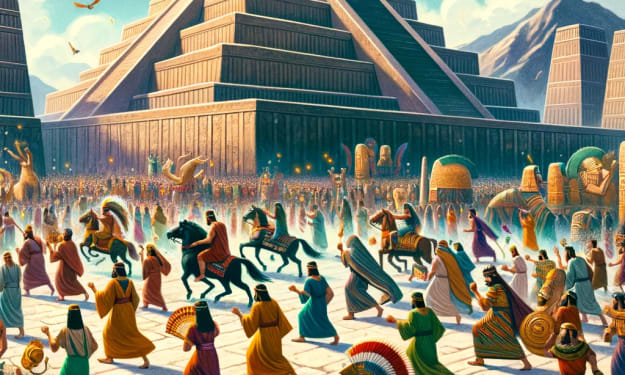A Roman New Year's Celebration
Honoring Janus and Embracing Renewal

The ancient Roman celebration of New Year, known as the Kalends of January, held a special significance in their culture, echoing the cyclical nature of time and the perpetual cycle of beginnings and endings. Unlike our modern New Year's Eve festivities, which focus on a single night of revelry, the Roman New Year extended over several days, providing a more profound and reflective period to mark the passage of time and welcome the new year with open arms.
At the heart of this celebration was Janus, the two-faced god of gates, doors, and beginnings. Janus's dual nature, with one face looking back to the past and the other gazing towards the future, perfectly encapsulated the essence of the New Year – a time to reflect on the year gone by and to look forward with hope to the year ahead.
The Preparations for the Kalends of January
In the days leading up to the Kalends of January, the Roman populace engaged in various rituals and practices to cleanse themselves and their homes, preparing for the start of a new cycle. Houses were swept clean, fires were extinguished, and new candles were lit, symbolizing the removal of the old and the welcoming of the new.
On the eve of the Kalends, sacrifices were offered to Janus, the god of beginnings, seeking his favor and protection for the upcoming year. These sacrifices often included animals, such as rams and goats, as well as symbolic offerings like honey, dates, and figs, representing sweetness and abundance for the coming year.
The Ceremony of the Ludi Saturnales
The Kalends of January commenced with a grand ceremony known as the Ludi Saturnales, a series of theatrical performances, games, and festivities that lasted for several days. These celebrations were dedicated to Saturn, the god of agriculture and harvest, who symbolized abundance and prosperity.
During the Ludi Saturnales, social norms were temporarily inverted, allowing slaves and masters to exchange roles and engage in merrymaking without the usual restrictions. This reversal of roles reflected the spirit of renewal and the blurring of boundaries between social classes during the New Year.
The Feasting and Gift-Giving
The Roman New Year was a time for feasting and indulging in various delicacies, often centered around roasted meats, fruits, and sweet pastries. Homes were decorated with evergreens and garlands, symbolizing the enduring nature of life.
Gift-giving also played a significant role in the New Year celebrations. Friends and family exchanged small tokens of affection, often including edible items like cakes, honey, and nuts, symbolizing prosperity and goodwill for the coming year.
The Renewal of the Government and the Calendar
The Kalends of January also marked the renewal of the Roman government, with the appointment of new magistrates and officials. This symbolized a fresh start for the governing body and a renewed commitment to the well-being of the Roman state.
In addition, the Kalends of January marked the beginning of the Roman calendar, with the first month of the year named after Janus, the god of beginnings. This symbolic connection reinforced the importance of the New Year as a pivotal moment in the cycle of time.
The Enduring Legacy of the Roman New Year
The Roman New Year celebrations, centered on the worship of Janus and the symbolism of renewal, left a lasting impact on Western cultures. Elements of the Kalends of January, such as the exchange of gifts and the symbolic reversals of roles, can still be observed in modern New Year celebrations.
The Roman concept of Janus, the god with two faces, has also become a powerful metaphor for the human experience, encompassing both the past and the future. This dual nature reflects our capacity for reflection, introspection, and anticipation as we navigate the journey of life.
The ancient Roman New Year, with its emphasis on cleansing, sacrifice, feasting, and gift-giving, provided a profound and multifaceted experience for the Romans, marking the beginning of a new cycle and offering a glimpse of hope and renewal for the future. The legacy of these celebrations continues to resonate in our modern New Year traditions, reminding us of the cyclical nature of time, the importance of reflection and anticipation, and the enduring spirit of hope that lies at the heart of every new beginning.
**********************************************************************
Discover more insightful reads and expand your knowledge by exploring our related articles – each one offers a unique perspective and in-depth information on a range of fascinating topics. Click on the articles below to continue your journey of discovery!
Bhogi Pongal’s harvest festival
The traditions defining Makar Sankranti's observance
Pongal a festival of harvest in Tamil Nadu
About the Creator
Festive Fusion Finds
My insatiable curiosity about the world we live in and passion for uncovering its history and traditions drive me to explore the world we live in. I enjoy wandering through the pages of time, exploring how our world has been shaped by them.






Comments
There are no comments for this story
Be the first to respond and start the conversation.